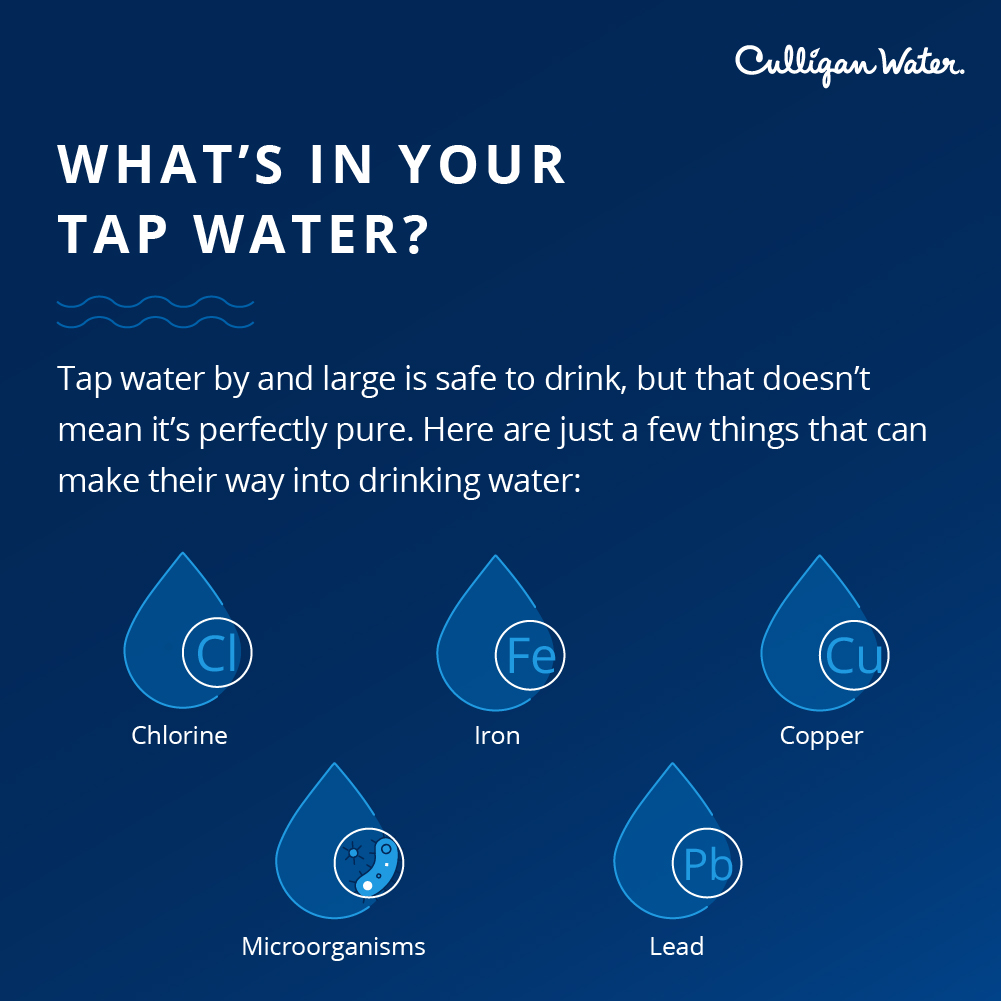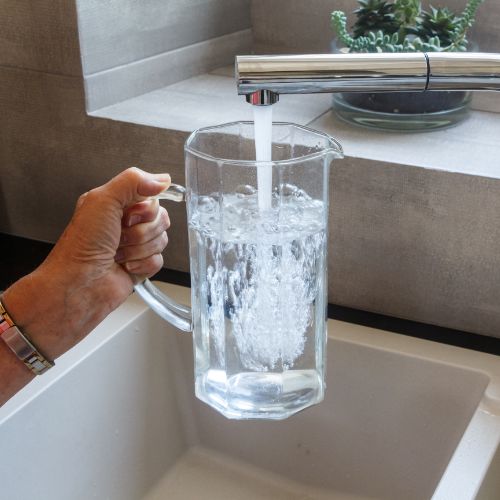There’s nothing more refreshing than a cool, crisp drink of water. But what’s really in your drinking glass?
Most places in North America generally have safe drinking water straight from the tap. However, that doesn’t mean tap water is always free from contaminants.* It might even have an odd taste, odor or color that, while not necessarily a health risk, certainly doesn’t inspire you to take another sip.
Here are just a few impurities that could be in your tap water supply:
- Calcium
- Magnesium
- Hydrogen sulfide
- Iron
- Lead
- Copper
- Chlorine
- PFAS or “forever chemicals”
To find out where these impurities come from, how to identify them and what your water treatment options are, it’s time to dive into the story of tap water. Start with this quick infographic, and then read on for more details
 Uncovering The Contents of Your Drinking Water
Uncovering The Contents of Your Drinking Water
Common water problems come in all shapes and sizes. Some are obvious as soon as you turn on the tap, while others might be hiding out in your drinking water supply. Let’s take a look at a few possibilities:
Calcium and Magnesium
Too much calcium and magnesium can lead to water hardness. Hard water doesn’t have a different odor, taste or color and doesn’t pose a significant threat to human health. However, it can cause a host of irritations, including:
- Dry skin
- Brittle hair
- Soap scum
- Spotty dishes
- Reduced lifetime of water-using appliances
Sound familiar? Download our FREE Hard Water Solutions Handbook.
Hydrogen Sulfide
If your water smells like rotten eggs, you might have a problem with sulfur bacteria. When the bacteria feed on naturally occurring sulfate, the result is hydrogen sulfide. This is especially common in well water and can also lead to unpleasant tastes and colors.
Iron
Your body needs a certain amount of iron, but too much can be a problem. That’s especially true when it comes to your water. Iron water contamination can cause yellowing teeth, metallic tastes, clogged pumps and even rust stains on fixtures and sinks.
Lead
Unlike other contaminant types, lead can pose a noteworthy health risk. Unfortunately, lead water contamination is difficult to detect without a water test. Tasteless, odorless and invisible, lead doesn’t even leave stains to indicate its presence as iron and hard water do.
Copper
Like iron, your body needs copper to keep you healthy. Overexposure to copper, however, can cause gastrointestinal discomfort and may even lead to problems like liver damage. Copper can also give your water a metallic taste and might leave characteristic green stains on fixtures, toilets and other parts of your home.
Chlorine
Chlorine is used in many water treatment facilities, which means it’s not necessarily a contaminant. However, chlorine water can lead to issues like unpleasant odors and tastes. Chlorine can also occasionally interact with your plumbing and cause copper, lead or other contaminants to leach into your tap water.
In large, sustained quantities, this additive can also cause eye and nose irritation as well as chronic upset stomach. Chlorine’s chemical neighbor, chlorine dioxide, which is used to treat and control microbes, has been known to cause anemia in infants and certain nervous system effects.
Chromium
Chromium is a mineral found in nature along with many human-made products. Like lead, it’s difficult to detect and may have negative health effects at high intake levels.
PFAS
PFAS are also known as per- and polyfluorinated substances or, perhaps more memorably, “forever chemicals.” They earned this nickname because they break down slowly in both the environment and your body. Unfortunately, PFAS are more dangerous than previously thought; it turns out that these compounds pose risks even in undetectable amounts. Health effects could include:
- Increased cancer risks
- Increased cholesterol
- Fertility issues
- Immune system issues
Both the EPA and Canadian Drinking Water Guidelines have set low thresholds for “safe” levels of PFAS; both the U.S. and Canada are exploring regulations around levels in drinking water, but these are not yet in place.
Microorganisms
When we think of odorless and tasteless contaminants, microorganisms are among the more obvious offenders, as they can go relatively undetected in water and cause pretty major problems. Common microorganisms like cryptosporidium and giardia, and perhaps the less common legionella, can all pass a sniff or taste test — but they still cause severe stomach upset and potentially pneumonia.
Inorganic Chemicals
Arsenic falls into this category, as well as other substances such as fluoride and asbestos. Some, including arsenic and asbestos, can create immediate health problems and irritations.
Other Contaminant Types
Mercury and nitrates also make the list of hard-to-detect chemicals, given that they can generally pass undetected in water. The only way to identify them is a water test.
What To Know About Drinking Water Contaminants
Now that you’ve learned to identify water contaminants from iron and copper to PFAS chemicals and microorganisms, it’s time to find out how to use this information. Here’s a little foundational knowledge to help you make sense of water quality research:
Can You Detect Every Contaminant?
Some contaminants are easy to identify — like chlorine, which generally has that familiar swimming pool smell. Others, however, are invisible to the senses. For example, you wouldn’t be able to smell, taste or see lead in your drinking water. For this reason, it’s important to have a professional water test and consultation, which can uncover what might be hiding in your tap water.
How Often Should You Have a Water Test?
Water tests are recommended generally at least once a year, whether you use city or private well water. That being said, you should test more frequently if there are known issues in your area or — in the case of well water — after certain events, such as a natural disaster, work on your well or wastewater system malfunction.
Is Your Water Quality Similar to Your Neighbor’s?
Let’s say that your neighbor just had a water test completed and it suggested no issues of immediate concern. Does that mean the same can be said for your home’s water?
Not so fast. Water quality changes from location to location, which means your neighbor’s water test doesn’t apply to your home. For example, maybe your water is more acidic, which could cause your copper pipes to contaminate your water — but because your neighbor’s water is alkaline, they don’t have the same problem.
Why Tap Water is Generally Safe To Drink
While it’s helpful to have the facts about any type of water contaminant that could be in your drinking glass, it’s important to keep some perspective, too. The public water system — and many private wells — consistently provide water that is generally safe to use for cooking, cleaning, bathing and drinking.
Many North American households’ water quality issues have to do with odor, taste and color — concerns that affect enjoyment but not safety. Nonetheless, appearance and flavor issues might prompt you to drink less water than you otherwise might, hampering your hydration efforts. There are also issues such as water hardness, which can cause trouble for your home even if they don’t impact you or your family’s health.
The key takeaway: It’s vital to know exactly what’s in your drinking glass, but that doesn’t mean you should stop trusting your tap and switch to single-use bottled water.
Worried about water problems?
Find simple answers with our Water Solutions Finder.
Discovering Where Your Tap Water Comes From
The story of your tap water starts long before you reach for a glass. To understand water quality and how to enhance it for your home, you need to start from the beginning. Let’s take a look:
Where Does Tap Water Come From?
Tap water generally comes from one of two sources: surface water or groundwater.
Surface water is what you see in lakes, rivers and streams. It’s also kept in reservoirs — human-made lakes that have been used since at least 3000 B.C. The amount of available water in these areas can change over time, as surface water is often fed by precipitation and snowmelt.
Groundwater travels below the surface, where it filters through soil, sand and rock to reach natural storage spaces such as aquifers. Groundwater is an important part of the North American water system, as 30% of Canadians and 51% of Americans rely on it for drinking, bathing, cleaning and irrigation. Furthermore, most private well water is sourced from groundwater.
Is All Tap Water Treated?
Untreated water isn’t necessarily clean or safe. Consider what surface water is exposed to: plant life, animal waste and chemicals like those found in sunscreen. Groundwater, meanwhile, comes into contact with sand, dirt and silt as it moves through the earth.

That’s why the EPA passed the Safe Drinking Water Act in 1974 and has amended it multiple times since. Every public water system in the U.S. must follow EPA regulations; many of these systems use water treatment solutions such as chlorine to kill bacteria and viruses.
The same is true in Canada, where the Guidelines for Canadian Drinking Water Quality set maximum acceptable concentrations of different contaminant types. Public water systems in the U.S. and Canada are required to produce annual water quality reports that can give consumers served by those systems more insight into what’s in their water.
But not every home’s water goes through publicly provided water treatment. For example, if you own a private well, you’re responsible for your own water quality — and you won’t get that helpful water quality report.
Is Treated Water the Same as Pure Water?
The truth is that water isn’t generally “pure” even after municipal water treatment. For example, even “clean water” might contain chlorine — and while chlorine water is usually safe to drink, it can still create unpleasant odors or tastes. Additionally, there are emerging contaminants not yet included in municipal drinking water safety standards.
The presence of chlorine in tap water is generally exclusive to city water, as wells don’t go through water treatment with this disinfectant. However, well water may contain contaminants such as lead or arsenic.
Ensure The Best Water Quality for Your Home
To know more about what’s happening when you turn on the tap — and why your water might be causing spotty dishes, copper stains, odd odors and other issues — you need to understand what’s in your water.
Get started today. Schedule your free, in-home water test and consultation.
*Contaminants may not be present in your water.




